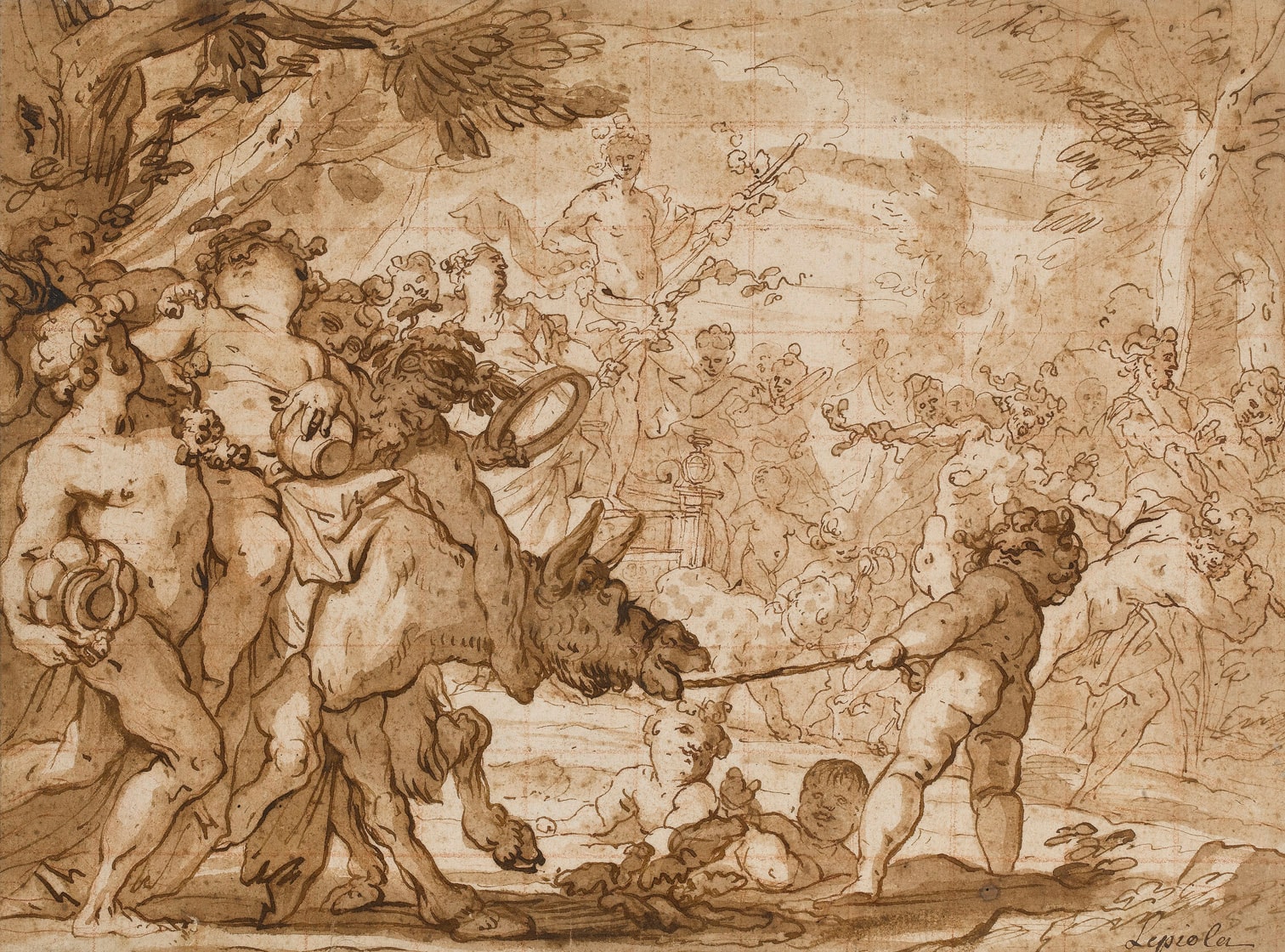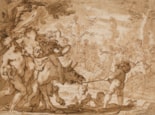Domenico PIOLA
(Genoa 1627 - Genoa 1703)
The Triumph of Bacchus
Sold
Pen and brown ink and brown wash, squared for transfer in red chalk.
Inscribed Lepiola at the lower right.
Laid down on an 18th century French mount, with the anonymous mountmaker’s drystamp ARD (Lugt 172) at the lower right of the mount.
231 x 310 mm. (9 1/8 x 12 1/8 in.)
ACQUIRED BY THE MUSEUM OF FINE ARTS, HOUSTON, TX.
Inscribed Lepiola at the lower right.
Laid down on an 18th century French mount, with the anonymous mountmaker’s drystamp ARD (Lugt 172) at the lower right of the mount.
231 x 310 mm. (9 1/8 x 12 1/8 in.)
ACQUIRED BY THE MUSEUM OF FINE ARTS, HOUSTON, TX.
With its spirited use of pen and wash, this drawing is one of the very finest and most elaborate examples of Domenico Piola’s fluent and spirited draughtsmanship. Although squared for transfer, it remains unrelated to any known painting or fresco by the artist. A large and finished drawing by Piola of a related subject of A Bacchanal with the Drunken Silenus on an Ass was on the art market in London in 1971 and was, until recently, in a private collection in Genoa, while a painting of a similar composition, though different subject, is the large Chariot of the Sun in the Palazzo Rosso in Genoa.
Working almost exclusively in his native Genoa, Domenico Piola can be counted among the most important and influential artists active in Liguria in the second half of the 17th century. He was the leading member of a local artistic dynasty, and one of the most sought-after decorative fresco painters in the city. (C. G. Ratti, in his biography of the artist, notes that there were so many houses in Genoa decorated by Piola that it would be too tiring to list them all - ‘son tanti di stancare qualunque penna’.) Working on the large-scale fresco decoration of numerous churches, palaces and villas, Piola occasionally collaborated with Valerio Castello (in the churches of Santa Maria della Passione and Santa Marta), and later often worked with his son-in-law, Gregorio de Ferrari. The 1670’s and 1680’s mark the peak of Piola’s activity as a frescante in Genoa, culminating in such works as the extensive decoration of the church of San Luca and the allegorical ceiling frescoes of Autumn and Winter in the Palazzo Rosso, painted between 1687 and 1688.
The French bombardment of Genoa in May 1684, however, led to the destruction of much of Piola’s work in various churches and palaces in the city, as well as the contents of his home and studio, and relatively few paintings and drawings from the first part of his career survive today. At the height of his reputation, Piola was the undisputed leader of the Genoese school, supervising a large and busy studio, known as the ‘Casa Piola’, which included his three sons Paolo Gerolamo, Giovanni Battista and Anton Maria Piola. He left a significant body of work and, with the Casa Piola active into the 1760’s, his influence remained predominant in his native city for many years after his death.
Domenico Piola remains one of the most prolific Genoese draughtsmen of the 17th century, despite the fact that many of his drawings were destroyed in a fire in his studio caused by the naval bombardment of the city in 1684. (As such, it may be assumed that much of the artist’s surviving drawings should be dated to the last two decades of his career.) Piola’s facility as a draughtsman was aptly described by his biographer Ratti, who notes that the artist ‘used to spend the whole evening drawing at the small table, setting down ideas on paper in pen with light shading in bistre...the facility of this method of drawing came no less easily to him than that of painting. Hence he made so many drawings that besides the largest number destroyed by a fire in his house and apart from those in the possession of foreigners and other painters in the city, his heirs preserved more than four thousand of them. And the wonder is that in such a copious number, one never encounters in any one example an invention similar to others already executed by him.’ A large and representative group of drawings by Piola and his circle, from the collection of the Genoese diplomat Jacopo Durazzo, is today in the Staatsgalerie in Stuttgart, while another important group is in the Palazzo Rosso in Genoa.
Provenance
Private collection, France.
Literature
Daniele Sanguinetti, ‘I percorsi di Domenico Piola’, in Daniele Sanguinetti, Domenico Piola 1628-1703: Percorsi di pittura barocca, exhibition catalogue, Genoa, 2017-2018, pp.15-16, fig.9.




